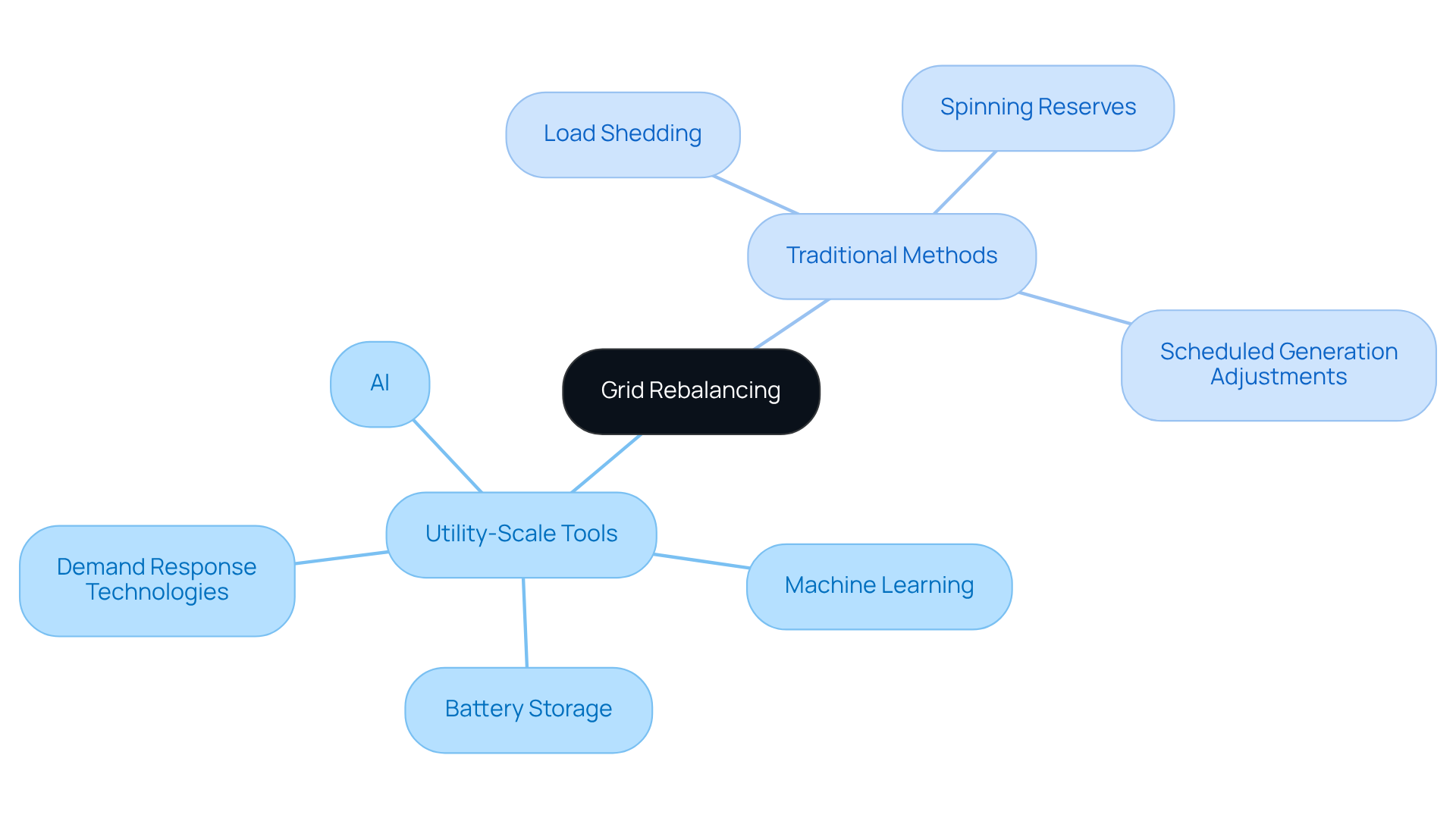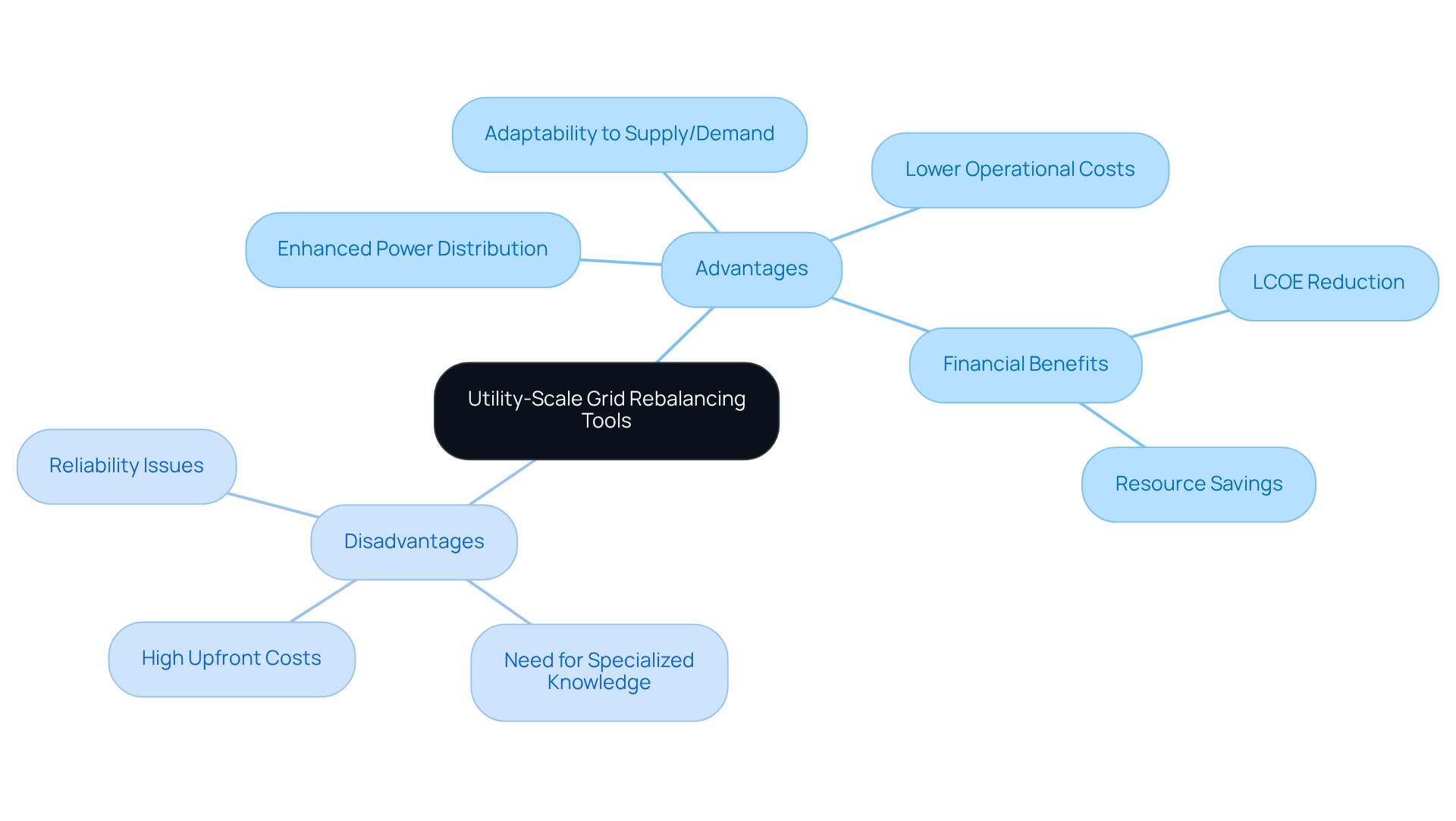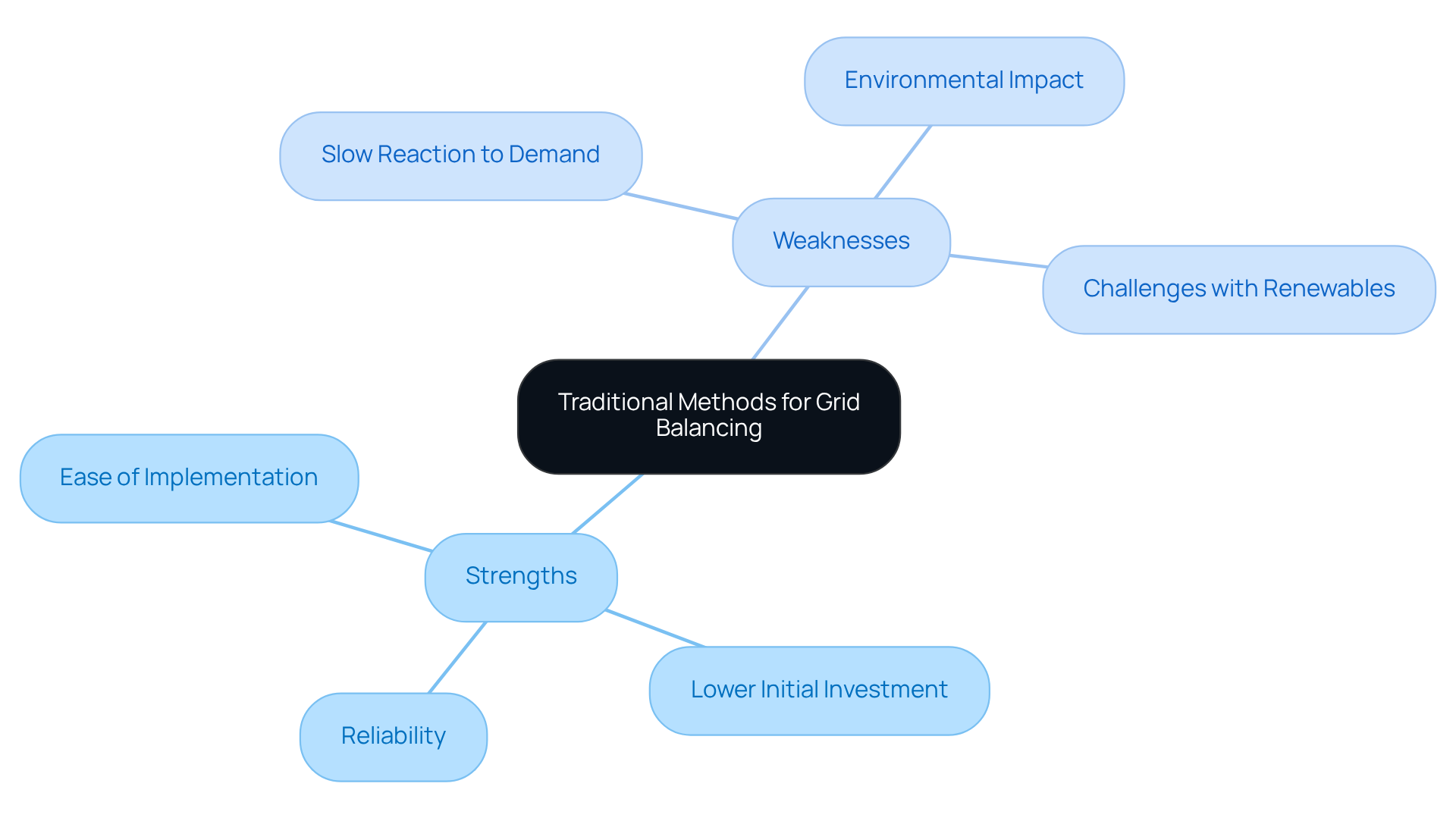Overview
This article presents a compelling comparison between utility-scale grid rebalancing tools and traditional methods, emphasizing that the former significantly enhances efficiency, adaptability, and long-term cost savings, especially in the management of renewable energy sources. Evidence of substantial advancements in real-time data analytics and AI integration supports this claim, demonstrating a remarkable capacity for responsiveness to fluctuations in energy supply and demand. In contrast, traditional techniques, which depend on manual adjustments and fossil fuels, exhibit slower and less flexible responses. This shift towards innovative technologies not only addresses current energy challenges but also positions organizations to thrive in an evolving energy landscape.
Introduction
As the energy landscape evolves, the methods employed to balance electricity distribution are undergoing a significant transformation. Utility-scale grid rebalancing tools, driven by advanced technologies such as AI and machine learning, promise enhanced efficiency and adaptability in managing power supply and demand. However, traditional methods, while historically reliable, often struggle to keep pace with the rapid changes in energy generation and consumption. This situation raises an important question: in a world increasingly reliant on renewable energy, how can organizations determine the most effective approach to grid balancing?
Understanding Utility-Scale Grid Rebalancing Tools and Traditional Methods
Utility-scale grid rebalancing tools represent a significant advancement in the management and enhancement of electricity distribution across extensive systems. These tools harness AI, machine learning, and real-time data analytics to improve efficiency and reliability. For instance, battery storage systems and demand response technologies are designed to adapt actively to fluctuations in power supply and demand, facilitating a more responsive and flexible network management approach. In 2024, the U.S. battery storage market added 12.3 GW of installed capacity, a remarkable 33% increase over the previous year, underscoring the growing dependence on these advanced technologies.
Conversely, traditional techniques for balancing the system often necessitate manual adjustments and depend on conventional power generation sources, including fossil fuels and hydroelectric energy. Methods such as:
- Load shedding
- Spinning reserves
- Scheduled generation adjustments
are frequently utilized. While these techniques can prove effective, they typically lack the adaptability and speed of utility-scale grid rebalancing tools, making them less suitable for the rapidly evolving power landscape. Experts in the field emphasize that integrating AI and machine learning into network management not only enhances operational efficiency but also improves the ability to respond to real-time demand fluctuations. This ultimately leads to a more robust and sustainable power infrastructure.

Advantages and Disadvantages of Utility-Scale Grid Rebalancing Tools
The advantages presented by utility-scale grid rebalancing tools significantly enhance energy management.
These tools enhance power distribution in real-time, minimizing waste and boosting overall grid effectiveness. For instance, the incorporation of advanced technologies has been demonstrated to enhance operational performance, resulting in significant resource savings.
They adeptly respond to fluctuations in energy supply and demand, making them particularly effective for incorporating renewable energy sources. This adaptability is crucial as the U.S. solar fleet is projected to grow from 177 GWdc in 2023 to 673 GWdc by 2034, necessitating responsive grid management.
Over time, the deployment of advanced technologies can result in lower operational costs compared to traditional methods. The levelized cost of power (LCOE) for new solar projects decreased to $31/MWh when considering federal incentives, emphasizing the financial advantages of contemporary power solutions. However, it is important to note that the LCOE for new projects increased slightly to $46/MWh before tax credits in 2023, indicating fluctuations in cost trends that organizations must consider.
Despite these advantages, notable disadvantages exist.
-
The upfront costs associated with implementing these technologies can be substantial, potentially deterring some organizations from making the transition. This is particularly relevant in a market where initial capital outlay remains a critical consideration for utilities, especially given the impact of high interest rates on financing options.
-
The incorporation of sophisticated instruments requires specialized knowledge and training, which can present an obstacle for certain utilities. As the industry evolves, the demand for skilled personnel to manage these systems will increase, adding to operational challenges.
-
Like any technology, new systems may raise reliability issues, especially in critical infrastructure. Ensuring consistent performance is vital, particularly as the energy landscape becomes increasingly complex with the rise of distributed energy resources.
In summary, while utility-scale grid rebalancing tools offer substantial advantages in efficiency, flexibility, and long-term cost savings, the challenges of high initial investment, complexity, and reliability must be carefully managed to fully realize their potential.

Evaluating Traditional Methods for Grid Balancing: Strengths and Weaknesses
Traditional methods for grid balancing present a unique blend of strengths and weaknesses that warrant examination.
Strengths of Traditional Methods: These techniques have been utilized for decades, offering a proven history of reliability. They frequently demand a smaller initial investment than advanced technologies, making them an attractive option for many stakeholders. Additionally, many conventional approaches are straightforward and do not require complex technology or extensive training, ensuring ease of implementation.
Weaknesses of Traditional Methods: However, these methods are not without their drawbacks. Conventional approaches can be slow to react to abrupt shifts in demand or supply, resulting in inefficiencies that can hinder performance. Furthermore, reliance on fossil fuels and other non-renewable sources contributes to higher emissions and environmental degradation, raising concerns about sustainability. As the power landscape transitions towards renewables, conventional approaches struggle to adapt to the variability of these sources, limiting their effectiveness in a rapidly changing environment.
In conclusion, while traditional methods for grid balancing offer certain advantages, their limitations in flexibility, environmental impact, and integration with renewable energy sources necessitate a reevaluation of their role in modern energy systems.

Comparative Analysis: When to Use Utility-Scale Tools vs. Traditional Methods
When evaluating the choice between traditional methods and utility-scale grid rebalancing tools, several key factors warrant consideration.
For extensive projects with significant power requirements, utility-scale grid rebalancing tools demonstrate greater effectiveness due to their ability to handle real-time variations. These tools manage the complexities of high-capacity systems, ensuring stability and efficiency. Notably, the utility-scale grid rebalancing tools segment deployed over 41 GW in 2024, showcasing its capability to meet substantial energy needs.
-
Budget Constraints: While organizations with limited budgets may initially lean towards traditional methods, it is essential to consider the long-term savings associated with advanced technologies. The average annual CAPEX reduction rate of 1.9% between 2035 and 2050 in the Conservative Scenario illustrates potential cost benefits over time, offsetting initial investments in utility-scale grid rebalancing tools.
-
In regions with stringent emissions regulations, utility-scale grid rebalancing tools are often necessary to achieve compliance and meet sustainability targets. Their advanced capabilities enable improved integration of renewable power sources, which is increasingly crucial in today's regulatory landscape. The Inflation Reduction Act has also encouraged solar installation, underscoring the significance of regulatory backing in management choices.
-
Integration of Renewables: Projects that incorporate significant renewable power sources benefit from the flexibility and responsiveness provided by utility-scale grid rebalancing tools. These systems are designed to adapt to the changing characteristics of renewables, enhancing overall network reliability. For instance, the integration of distributed energy resources (DERs) is vital for optimizing grid operations and ensuring reliability.
-
Operational Complexity: Organizations equipped to manage complex systems can reap substantial benefits from investing in utility-scale grid rebalancing tools. Conversely, simpler operations may find conventional approaches more suitable, as they require less technical oversight. As Tom Keefe pointed out, utilities are increasingly pursuing partnerships to expedite advanced reactor deployment, emphasizing the collaborative method required in managing intricate power systems.
In summary, the decision between utility-scale and traditional methods hinges on project scale, budget considerations, regulatory requirements, renewable integration, and operational complexity. Understanding these factors can guide organizations in making informed energy management decisions.

Conclusion
Utility-scale grid rebalancing tools have emerged as a transformative force in managing electricity distribution, offering enhanced efficiency and adaptability compared to traditional methods. These advanced technologies, which incorporate AI and real-time data analytics, are essential for responding to the dynamic demands of modern energy systems. As the need for sustainable and reliable power sources grows, understanding the strengths and weaknesses of both utility-scale tools and traditional methods becomes crucial for energy organizations.
The article highlights several key insights:
- Utility-scale tools provide significant advantages in managing real-time fluctuations.
- They improve integration with renewable energy sources.
- They ultimately lead to long-term cost savings.
In contrast, traditional methods, while historically reliable and less expensive upfront, struggle with flexibility and environmental impact. This comparative analysis underscores the importance of considering project scale, budget constraints, and regulatory requirements when choosing between these approaches.
In a rapidly evolving energy landscape, the decision to adopt utility-scale grid rebalancing tools or stick with traditional methods should be informed by a comprehensive understanding of their respective benefits and challenges. Organizations are encouraged to evaluate their unique circumstances and operational capabilities to make informed choices that align with sustainability goals and operational efficiency. Embracing advancements in grid management technology is not merely a trend; it is a necessary step towards a more resilient and environmentally conscious energy future.
Frequently Asked Questions
What are utility-scale grid rebalancing tools?
Utility-scale grid rebalancing tools are advanced technologies that utilize AI, machine learning, and real-time data analytics to enhance the management and efficiency of electricity distribution across large systems.
How do utility-scale grid rebalancing tools improve network management?
These tools improve network management by actively adapting to fluctuations in power supply and demand, facilitating a more responsive and flexible approach to electricity distribution.
What notable advancements occurred in the U.S. battery storage market in 2024?
In 2024, the U.S. battery storage market added 12.3 GW of installed capacity, representing a 33% increase over the previous year, highlighting the growing reliance on advanced technologies for energy management.
What are some traditional methods for balancing the electricity system?
Traditional methods for balancing the electricity system include load shedding, spinning reserves, and scheduled generation adjustments. These methods often rely on manual adjustments and conventional power generation sources.
Why are traditional balancing methods considered less suitable for the evolving power landscape?
Traditional methods typically lack the adaptability and speed of utility-scale grid rebalancing tools, making them less effective in responding to the rapidly changing demands of the power landscape.
What are the benefits of integrating AI and machine learning into network management?
Integrating AI and machine learning into network management enhances operational efficiency and improves the ability to respond to real-time demand fluctuations, leading to a more robust and sustainable power infrastructure.




